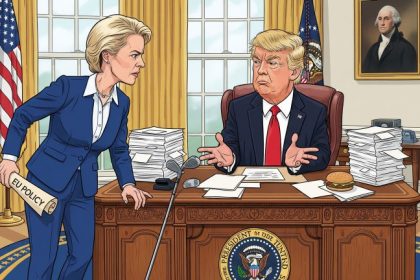The streets of Washington, D.C., once again became the stage for political unrest as thousands of demonstrators gathered outside the White House to voice their anger over former President Donald Trump’s controversial federal police initiative. What began as a series of smaller rallies in major American cities swelled into a national movement, with the White House as its symbolic epicenter. Protesters carried banners, chanted slogans, and demanded accountability, framing the federal takeover of local law enforcement as a dangerous erosion of civil liberties.
For weeks, tensions had been mounting after Trump announced an expanded role for federal officers in U.S. cities, a move his critics argue undermines state authority and threatens constitutional rights. The federal deployment—originally justified as a means to counter violent crime and safeguard federal property—was swiftly criticized by governors, mayors, and civil rights organizations who saw it as an authoritarian overreach. Against this backdrop, Saturday’s demonstration took shape as a flashpoint moment, uniting activists, students, veterans, and everyday citizens in a collective outcry against what they describe as “policing without consent.”
The rally was notable not just for its size but also for its diversity. Families marched alongside seasoned activists, clergy led prayers between chants, and veterans carried flags reimagined as symbols of dissent. Speakers from the steps of Lafayette Square highlighted stories of communities that had already felt the weight of federal intervention—cities where unmarked officers detained individuals without clear charges, and neighborhoods where tear gas and rubber bullets became part of daily life. “This isn’t law and order,” one speaker declared to a roaring crowd, “this is control and fear.”
While the demonstration remained largely peaceful, the atmosphere was thick with urgency. Organizers coordinated legal observers and medical volunteers, wary of confrontations that had marred similar protests in Portland and Chicago. The police presence in D.C. was heavy, though reports suggest authorities largely avoided direct engagement, perhaps mindful of the optics of clashing with a movement explicitly protesting excessive policing. Nonetheless, the sight of armored vehicles stationed blocks from the White House added to the sense of a city under siege.
Underlying the chants and banners was a deep constitutional debate. Supporters of Trump’s initiative argue that the federal government has both the right and the responsibility to intervene when local authorities fail to maintain order. They point to rising violent crime statistics and incidents of property damage as justification for extraordinary measures. Critics, however, counter that the federal government’s role is limited, and that the use of federal forces against U.S. citizens risks normalizing practices more common in authoritarian regimes than in democracies. Legal scholars warn that this conflict between federal and state power could end up in the courts, with implications far beyond policing.
For many demonstrators, the issue was also personal. Parents spoke of their children’s fear when sirens blared late at night. Students described being stopped and questioned by federal agents in their own neighborhoods. Civil rights groups have cataloged dozens of complaints alleging unlawful detentions, excessive force, and intimidation. These testimonies infused the protest with an emotional intensity, turning it from a political rally into a deeply human cry for justice.
The White House, for its part, dismissed the demonstration as partisan theatrics. Trump allies framed the protests as organized by political opponents seeking to weaken his authority. Yet, the sheer turnout and the broad coalition of groups represented suggest a more complicated picture. Labor unions, environmental organizations, and even veterans’ associations joined civil rights activists in condemning the federal takeover, signaling that opposition to Trump’s policing policy cuts across traditional political divides.
Economists and policy experts also weighed in, noting the long-term risks of militarized federal policing. Beyond civil liberties, they argue that strained relations between local communities and federal agencies could erode trust in government institutions. In cities where federal officers were deployed, some businesses reported drops in revenue, citing fears of unrest and heavy-handed crackdowns. Critics suggest that the supposed short-term security benefits may ultimately deepen economic and social instability.
International observers have taken note, too. Human rights organizations and foreign media outlets framed the events in Washington as emblematic of democratic backsliding in the United States. For allies abroad, images of heavily armed officers patrolling American streets clash with the nation’s self-image as a beacon of liberty. For adversaries, they serve as propaganda fodder, highlighting what they see as hypocrisy in U.S. calls for human rights abroad.
What happens next remains uncertain. Some lawmakers in Congress are calling for immediate hearings on the legality of Trump’s federal police actions. Civil rights groups are preparing lawsuits aimed at challenging the initiative in court. Meanwhile, organizers vow that the protests will continue, with plans for nationwide demonstrations in the coming weeks. “This is not just about one city or one president,” said a protest leader in D.C. “This is about what kind of country we want to live in, and what freedoms we are willing to defend.”
Saturday’s march may not have changed federal policy overnight, but it marked an important moment in the unfolding story of American democracy. The image of thousands gathered outside the White House—angry, determined, yet resolutely peaceful—was a powerful reminder that even in times of fear and division, citizens continue to claim their right to dissent. Whether that dissent leads to change remains to be seen, but for those in the streets, the message was clear: they will not be silent in the face of federal power unchecked.
In the end, the protest was not only about Trump’s police takeover but also about the larger questions of accountability, freedom, and the fragile balance between security and liberty. The chants may fade, the banners may come down, but the echoes of that march outside the White House will linger in America’s conscience, urging a reckoning with the choices made in the name of law and order.




